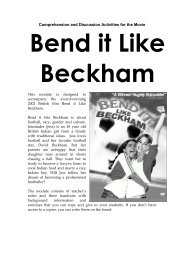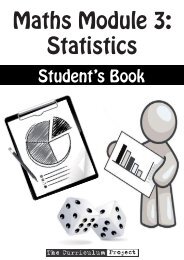General English Pre-Intermediate Modules 1-4 Teacher's Guide (2.1 ...
General English Pre-Intermediate Modules 1-4 Teacher's Guide (2.1 ...
General English Pre-Intermediate Modules 1-4 Teacher's Guide (2.1 ...
You also want an ePaper? Increase the reach of your titles
YUMPU automatically turns print PDFs into web optimized ePapers that Google loves.
4.2 Describing rooms<br />
A. Elicit definitions of the adjectives for describing rooms. Students should use their dictionaries if<br />
necessary. Elicit opposites to the adjectives, and write them on the board.<br />
Answers: cool – warm spacious – crowded/small messy – tidy dark – light<br />
comfortable – uncomfortable large – small clean – dirty<br />
B. Students decide which adjective can describe which item.<br />
Answers:<br />
1. room – all of them: cool, spacious, messy, tidy, dark, comfortable, large, light, clean<br />
2. table – messy, tidy, large, small, clean, dirty<br />
3. cooker – large, small, clean, dirty<br />
C. <strong>Pre</strong>-teach study (in this context, it is a room in your home you use as an office or study area) and<br />
wooden (made of wood). Students read the texts.<br />
D. Play audio 4.6. Students listen, and identify what information is differ nt between the written texts and the<br />
spoken texts by writing down the different information they hear. There are five differences in each text.<br />
Then they can look at the audioscripts to check their answers.<br />
Answers:<br />
My daughters’ bedroom is large and spacious – it’s the biggest room in the house. We have five daughters,<br />
so they need a lot of space! It’s got two sleeping mats and two mosquito nets and a bamboo shelf for their<br />
clothes. They’ve got posters on the wall of their favourite actors and pop singers, and photographs of their<br />
grandparents. It’s a cool, comfortable room, with a window opposite the door.<br />
My favourite room is my study. I go there for peace and quiet, because there are lots of people living in my<br />
house! It’s quite a small room, with a chair, a shelf full of old books, a cassette player and a desk. I sit there<br />
every evening and read. It’s very messy – I never tidy it. But I don’t mind a bit of mess. It makes the place<br />
more comfortable.<br />
4.3 Pairwork: Listen and draw<br />
These activities might take a long time, so skip them if necessary.<br />
A. <strong>Pre</strong>-teach supplies. Play audio 4.7 two or three<br />
times. Students listen, and draw tant; they should<br />
try to include all the things in the description.<br />
Give them a few minutes to do their drawing,<br />
then play the audio again to check.<br />
Answer: The picture should look a bit like this:<br />
B. In pairs, students describe their favourite rooms<br />
to each other, and draw their partners’ rooms.<br />
Then they check each other’s drawings for<br />
accuracy.<br />
5. Adverbs of degree<br />
This section looks at using adverbs of degree to modify adjectives. Adverbs of degree tell us about the intensity<br />
(strength) or amount of an action, an adjective or another adverb.<br />
5.1 How short are they<br />
A. Students look at the pictures, read the text and identify the people.<br />
Answers:<br />
left to right – Dennis, Ni Ni, Roi Ja, Johnny, U Zagana<br />
B. Students read through the text, and decide which words and phrases are adverbs of degree. If necessary,<br />
refer them to the Adverbs of degree section of the Language Reference.<br />
Answers:<br />
extremely, really, very, fairly, quite, not very<br />
Module 4 57



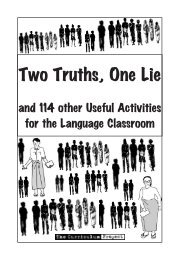
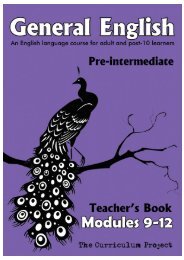


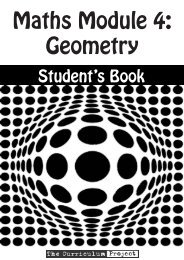

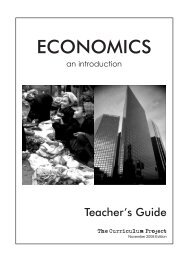
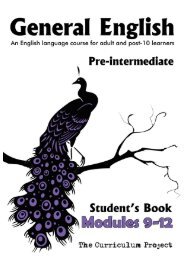

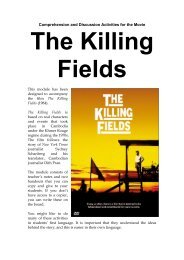
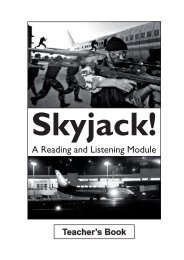
![[Eng] Nov 2012 DRAFT - The Curriculum Project](https://img.yumpu.com/45590859/1/184x260/eng-nov-2012-draft-the-curriculum-project.jpg?quality=85)
